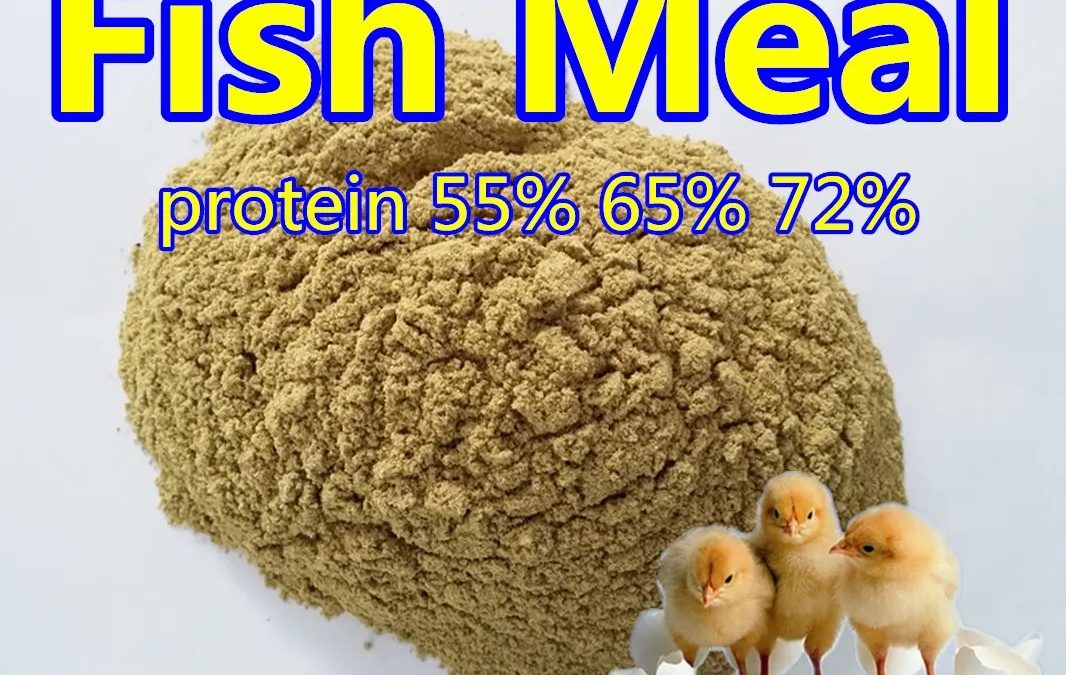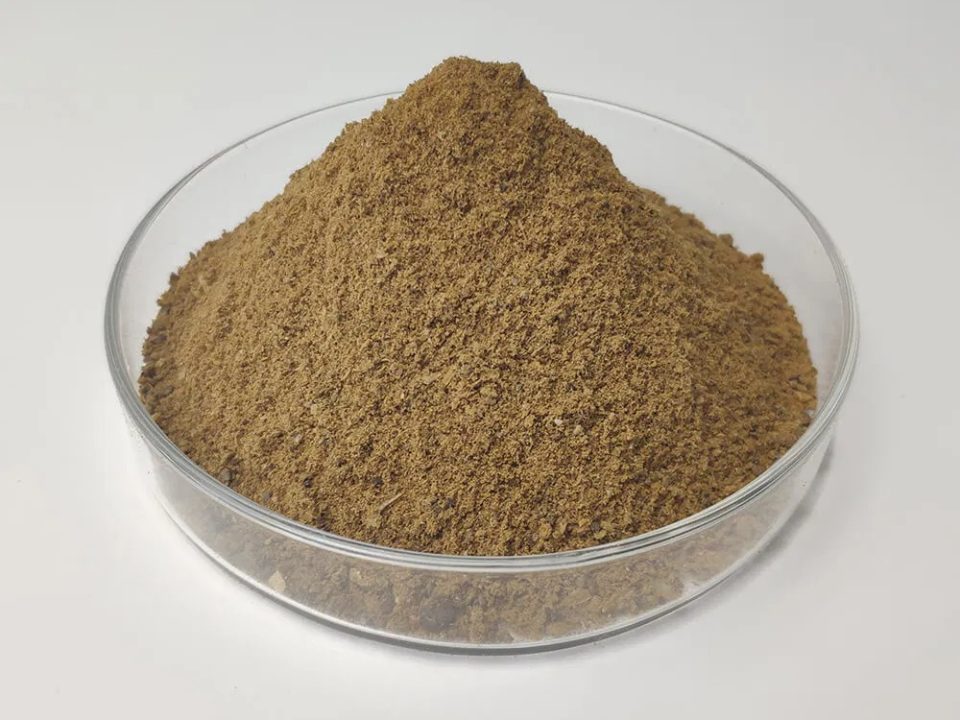Effects of Fish Meal Powder on Animal Fat Metabolism and Gut Microbiota

Fish Meal Powder Feed Additives 72% Protein
April 3, 2025
Chicken meal for Feed Ingredients & Additives Research
April 13, 2025Effects of Fish Meal Powder on Animal Fat Metabolism and Gut Microbiota: A Comprehensive Analysis
Introduction
Fish meal powder, a high-protein feed additive typically containing 65-72% crude protein, is derived from small pelagic fish (e.g., anchovies, sardines) or fishery byproducts through cooking, pressing, drying, and grinding. Beyond its role as a rich source of amino acids, fish meal influences animal physiology, particularly fat metabolism and gut microbiota composition. These effects are critical in aquaculture, poultry, swine, and pet nutrition, where dietary protein sources shape metabolic health, growth performance, and disease resistance.
This analysis examines the impact of fish meal powder on fat metabolism and gut microbiota, comparing it with soybean meal (plant-based), poultry by-product meal (animal-based), and insect meal (black soldier fly larvae, an emerging alternative). Key parameters include lipid content, fatty acid profiles, digestibility, and microbial modulation, supported by scientific evidence and presented in a tabular format followed by detailed discussion.
Comparison Table
| Parameter | Fish Meal Powder (72% Protein) | Soybean Meal (44-48% Protein) | Poultry By-Product Meal (60-65% Protein) | Insect Meal (BSF, 50-60% Protein) |
|---|---|---|---|---|
| Crude Protein (%) | 72 | 44-48 | 60-65 | 50-60 |
| Lipid Content (%) | 6-10 | 1-2 | 10-15 | 15-20 |
| Fatty Acid Profile | High in omega-3 (EPA, DHA: 1-3%) | Low, mostly omega-6 (linoleic acid) | Moderate, mostly saturated/monounsaturated | High in lauric acid (C12:0), low omega-3 |
| Digestibility (%) | 85-95 | 75-85 | 80-90 | 80-85 |
| Effect on Fat Metabolism | Enhances lipid oxidation, reduces fat deposition | Minimal effect, may increase visceral fat | Increases lipid storage, variable oxidation | Promotes lipid mobilization, antimicrobial effects |
| Gut Microbiota Modulation | Increases Firmicutes, reduces Proteobacteria | Increases Bacteroidetes, variable Firmicutes | Increases Firmicutes, some Proteobacteria | Increases Actinobacteria, prebiotic from chitin |
| Short-Chain Fatty Acid (SCFA) Production | Moderate (butyrate, acetate) | High (acetate, propionate from fiber) | Low to moderate (butyrate) | Moderate (acetate, butyrate from chitin) |
| Anti-Nutritional Factors (ANFs) | None | Present (phytates, trypsin inhibitors) | Minimal | Minimal (chitin may limit digestibility) |
| Inflammatory Response | Reduced (omega-3 anti-inflammatory) | Neutral to mild increase (ANFs) | Neutral to mild increase | Reduced (lauric acid antimicrobial) |
| Cost (USD/ton, approx.) | 1500-2000 | 400-600 | 800-1200 | 1000-1500 |
Scientific Analysis
1. Effects on Fat Metabolism
Fish Meal Powder (72% Protein): Fish meal’s lipid content (6-10%) is rich in long-chain polyunsaturated fatty acids (PUFAs), particularly omega-3s like eicosapentaenoic acid (EPA) and docosahexaenoic acid (DHA), typically constituting 1-3% of the dry matter. These fatty acids activate peroxisome proliferator-activated receptor-alpha (PPAR-α), a nuclear receptor that upregulates genes involved in fatty acid β-oxidation in the liver and muscle. Studies in fish (e.g., Atlantic salmon) and mammals (e.g., pigs) show that fish meal diets reduce visceral fat deposition and enhance lipid mobilization compared to diets lacking omega-3s. The high digestibility (85-95%) ensures efficient nutrient absorption, minimizing undigested lipids that could disrupt metabolism.
The mechanism involves increased mitochondrial biogenesis and reduced lipogenesis, mediated by lower expression of sterol regulatory element-binding protein-1c (SREBP-1c). This makes fish meal particularly valuable for lean growth in carnivorous species and obesity prevention in pets. However, excessive dietary inclusion may elevate ash content (10-20%), potentially affecting mineral-lipid interactions and fat metabolism efficiency.
Soybean Meal (44-48% Protein): With a low lipid content (1-2%), soybean meal provides minimal direct influence on fat metabolism. Its fatty acid profile is dominated by omega-6 linoleic acid, which promotes lipid storage rather than oxidation when consumed in excess. The presence of ANFs like phytates and trypsin inhibitors reduces protein and lipid digestibility (75-85%), potentially leading to compensatory fat accumulation in animals like pigs and poultry. Research indicates that soybean meal diets increase visceral fat in omnivores compared to fish meal, partly due to lower PPAR-α activation and higher carbohydrate fermentation shifting energy to lipogenesis.
Poultry By-Product Meal (60-65% Protein): Containing 10-15% lipids, poultry by-product meal is rich in saturated and monounsaturated fatty acids but low in omega-3s. This profile favors lipid storage over oxidation, with studies in broiler chickens showing increased abdominal fat pads compared to fish meal diets. Digestibility (80-90%) is high, but variability in lipid quality (e.g., from oxidized fats in rendering) can impair metabolic efficiency. The lack of PUFAs limits its ability to modulate fat metabolism favorably, making it less ideal for lean growth applications.
Insect Meal (BSF, 50-60% Protein): Insect meal’s high lipid content (15-20%) includes medium-chain fatty acids (MCFAs) like lauric acid (C12:0), which enhance lipid mobilization by increasing uncoupling protein-1 (UCP-1) expression in mitochondria. This promotes thermogenesis and reduces fat deposition, as observed in poultry and fish trials. However, the absence of omega-3s limits its metabolic benefits compared to fish meal. Digestibility (80-85%) is slightly hampered by chitin, but the antimicrobial properties of lauric acid may indirectly support fat metabolism by reducing gut inflammation.
2. Effects on Gut Microbiota
Fish Meal Powder: Fish meal’s highly digestible protein and omega-3 content shape gut microbiota by increasing Firmicutes (e.g., Lactobacillus spp.), which ferment peptides into short-chain fatty acids (SCFAs) like butyrate and acetate. These SCFAs enhance gut barrier function and reduce inflammation via G-protein-coupled receptor (GPR) signaling. Concurrently, fish meal reduces Proteobacteria (e.g., Escherichia coli), a phylum linked to dysbiosis and metabolic endotoxemia. Studies in shrimp and salmon show that fish meal diets elevate microbial diversity and butyrate production, supporting intestinal health and fat metabolism synergy.
The absence of ANFs ensures minimal disruption to microbial ecosystems, unlike plant-based alternatives. However, high ash content may alter gut pH, subtly influencing microbial composition in species sensitive to mineral loads (e.g., pigs).
Soybean Meal: Rich in fermentable carbohydrates (e.g., oligosaccharides), soybean meal boosts Bacteroidetes (e.g., Prevotella spp.), which produce acetate and propionate. These SCFAs support energy harvest but may increase fat storage in omnivores if not balanced with protein fermentation. ANFs like phytates and lectins can irritate the gut lining, promoting Proteobacteria overgrowth and reducing microbial diversity in fish and poultry. Fermentation or enzyme treatment mitigates these effects, aligning microbiota closer to fish meal profiles, though omega-3 absence limits anti-inflammatory benefits.
Poultry By-Product Meal: With moderate lipid and protein fermentation, poultry by-product meal increases Firmicutes and, to a lesser extent, Proteobacteria. Butyrate production is lower than with fish meal, reflecting less microbial modulation of fat metabolism. Variability in rendering quality (e.g., heat-damaged proteins) can introduce microbial stressors, reducing beneficial taxa like Lactobacilli in poultry and swine. Its minimal ANF content is an advantage over soybean meal, but it lacks the prebiotic or anti-inflammatory drivers of fish or insect meals.
Insect Meal: Insect meal uniquely influences microbiota via chitin, a polysaccharide acting as a prebiotic. It increases Actinobacteria (e.g., Bifidobacterium spp.) and Firmicutes, boosting acetate and butyrate production. Lauric acid’s antimicrobial action suppresses pathogenic Proteobacteria, enhancing gut health in poultry and fish. Studies show improved microbial diversity and reduced inflammation, though chitin’s partial indigestibility may limit SCFA yields in some species (e.g., carnivorous fish), contrasting with fish meal’s higher protein-driven fermentation.
3. Interplay Between Fat Metabolism and Gut Microbiota
Fish Meal Powder: The synergy between omega-3s and microbiota is profound. EPA/DHA reduce gut-derived lipopolysaccharide (LPS) translocation, a trigger for inflammation and fat accumulation, while Firmicutes-derived butyrate enhances PPAR-α activity, amplifying lipid oxidation. This dual action makes fish meal a standout for metabolic health in carnivores.
Soybean Meal: High SCFA production from carbohydrates can increase energy harvest, potentially overwhelming lipid oxidation pathways and favoring fat storage. ANF-induced dysbiosis further disrupts this balance, reducing metabolic efficiency compared to fish meal.
Poultry By-Product Meal: Limited microbial modulation and a saturated fat profile result in weaker interplay, with fat metabolism relying more on dietary lipid uptake than gut-mediated effects. This reduces its efficacy in optimizing lean growth.
Insect Meal: Chitin and lauric acid create a unique metabolic-microbial axis, with SCFAs and MCFAs promoting lipid mobilization and gut health. While less potent than fish meal’s omega-3-driven effects, it offers a sustainable alternative with comparable anti-inflammatory benefits.
4. Practical Implications
Fish meal excels in aquaculture (e.g., salmon, shrimp) and pet diets, where fat metabolism and gut health directly impact growth and immunity. Its cost (1500-2000 USD/ton) and sustainability concerns limit widespread use, pushing blends with soybean meal (400-600 USD/ton) for cost-efficiency, though ANFs require processing. Poultry by-product meal (800-1200 USD/ton) suits omnivores like poultry, balancing fat storage with moderate gut benefits. Insect meal (1000-1500 USD/ton) is ideal for sustainable poultry and fish diets, leveraging microbiota to offset lower omega-3 content.
5. Limitations and Future Research
Fish meal’s reliance on finite fish stocks and high mineral content pose challenges, necessitating research into omega-3-enriched alternatives. Soybean meal’s ANFs demand advanced processing (e.g., fermentation), while poultry by-product meal’s variability calls for standardized production. Insect meal’s chitin digestibility and scalability require optimization. Comparative studies across species (e.g., fish vs. swine) will refine these applications.
Conclusion
Fish meal powder profoundly enhances animal fat metabolism and gut microbiota through its omega-3 content and high digestibility, reducing fat deposition and promoting beneficial microbial taxa like Firmicutes. Soybean meal, while cost-effective, lags due to ANFs and limited lipid influence. Poultry by-product meal offers moderate benefits but lacks the metabolic precision of fish meal, and insect meal emerges as a sustainable contender with unique microbial and fat-modulating effects. Blending these sources may optimize health outcomes, balancing nutrition, cost, and environmental impact in modern animal production.






